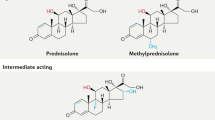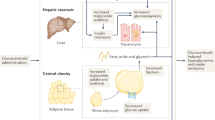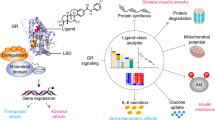Abstract
Glucocorticoid hormones exert a wide spectrum of metabolic and immunological effects. They function through the glucocorticoid receptor, a member of the nuclear receptor superfamily. Glucocorticoids are particularly effective as anti-inflammatory agents but often cause severe side effects. The structure of the ligand-binding domain of the glucocorticoid receptor has now been elucidated, and a series of studies have shown that even subtle changes to the ligand structure alter the final conformation of the ligand–receptor complex, with consequences for both protein recruitment and the function of the receptor. This has led to concerted efforts to find selective ligands for the glucocorticoid receptor that preserve the beneficial anti-inflammatory activity but reduce the side-effect profile. The direct health-care benefits of such a simple, safe, orally active agent targeting the underlying inflammatory process in, for example, rheumatoid arthritis would be considerable in terms of reduced patient suffering; furthermore, the indirect benefits in terms of reducing the costs of therapeutic delivery and preventing loss of productivity would be even greater.
Key Points
-
Glucocorticoids are the most potent anti-inflammatory agents known
-
Their use is limited by a wide spectrum of severe side effects
-
The mechanisms of action of glucocorticoids differ between anti-inflammatory and metabolic effects
-
Structural studies of the glucocorticoid receptor have enabled rational drug design
-
Novel ligands hold the promise of selective anti-inflammatory activity
This is a preview of subscription content, access via your institution
Access options
Subscribe to this journal
Receive 12 print issues and online access
$209.00 per year
only $17.42 per issue
Buy this article
- Purchase on Springer Link
- Instant access to full article PDF
Prices may be subject to local taxes which are calculated during checkout




Similar content being viewed by others
References
Hench PS et al. (1950) Effects of cortisone acetate and pituitary ACTH on rheumatoid arthritis, rheumatic fever and certain other conditions. Arch Med Interna 85: 545–666
Flower RJ et al. (1986) A comparison of the acute inflammatory response in adrenalectomised and sham-operated rats. Br J Pharmacol 87: 57–62
Laue L et al. (1988) Receptor-mediated effects of glucocorticoids on inflammation: enhancement of the inflammatory response with a glucocorticoid antagonist. J Steroid Biochem 29: 591–598
Brown HM et al. (1977) Beclomethasone dipropionate aerosol in treatment of perennial and seasonal rhinitis: a review of five years' experience. Br J Clin Pharmacol 4 (Suppl 3): 283S–286S
Gallant C and Kenny P (1986) Oral glucocorticoids and their complications. A review. J Am Acad Dermatol 14: 161–177
Crim C et al. (2001) A review of the pharmacology and pharmacokinetics of inhaled fluticasone propionate and mometasone furoate. Clin Ther 23: 1339–1354
Scribano M and Prantera C (2003) Review article: medical treatment of moderate to severe Crohn's disease. Aliment Pharmacol Ther 17 (Suppl 2): 23–30
Purdy IB and Wiley DJ (2004) Perinatal corticosteroids: a review of research. Part I: Antenatal administration. Neonatal Netw 23: 15–30
Belvisi MG et al. (2001) New glucocorticosteroids with an improved therapeutic ratio? Pulm Pharmacol Ther 14: 221–227
Guyre PM et al. (1984) Glucocorticoid actions on lymphoid tissue and the immune system: physiologic and therapeutic implications. Prog Clin Biol Res 142: 181–194
Cohan VL et al. (1989) Dexamethasone does not inhibit the release of mediators from human mast cells residing in airway, intestine, or skin. Am Rev Respir Dis 140: 951–954
Cupps TR et al. (1985) Effects of in vitro corticosteroids on B cell activation, proliferation, and differentiation. J Clin Invest 75: 754–761
Pilkis SJ and Granner DK (1992) Molecular physiology of the regulation of hepatic gluconeogenesis and glycolysis. Annu Rev Physiol 54: 885–909
McMahon M et al. (1988) Effects of glucocorticoids on carbohydrate metabolism. Diabetes Metab Rev 4: 17–30
Zkrzewska KE et al. (1997) Glucocorticoids as counterregulatory hormones of leptin: toward an understanding of leptin resistance. Diabetes 46: 717–719
Robson H et al. (2002) Interactions between GH, IGF-I, glucocorticoids, and thyroid hormones during skeletal growth. Pediatr Res 52: 137–147
Miao Y et al. (2007) Folic acid prevents and partially reverses glucocorticoid-induced hypertension in the rat. Am J Hypertens 20: 304–310
Cordero MI et al. (1998) Correlational relationship between shock intensity and corticosterone secretion on the establishment and subsequent expression of contextual fear conditioning. Behav Neurosci 112: 885–891
Cordero MI and Sandi C (1998) A role for brain glucocorticoid receptors in contextual fear conditioning: dependence upon training intensity. Brain Res 786: 11–17
Young EA et al. (1994) Increased evening activation of the hypothalamic-pituitary-adrenal axis in depressed patients. Arch Gen Psychiatry 51: 701–707
Cnalis E et al. (2007) Glucocorticoid-induced osteoporosis: pathophysiology and therapy. Osteoporos Int 18: 1319–1328
Solomon DH et al. (2006) Patterns of cardiovascular risk in rheumatoid arthritis. Ann Rheum Dis 65: 1608–1612
Wei L et al. (2004) Taking glucocorticoids by prescription is associated with subsequent cardiovascular disease. Ann Intern Med 141: 764–770
Lu NZ and Cidlowski JA (2004) The origin and functions of multiple human glucocorticoid receptor isoforms. Ann N Y Acad Sci 1024: 102–123
Ray DW et al. (1996) Glucocorticoid receptor structure and function in glucocorticoid-resistant small cell lung carcinoma cells. Cancer Res 56: 3276–3280
Lu NZ and Cidlowski JA (2005) Translational regulatory mechanisms generate N-terminal glucocorticoid receptor isoforms with unique transcriptional target genes. Mol Cell 18: 331–342
Drouin J et al. (1993) Novel glucocorticoid receptor complex with DNA element of the hormone-repressed POMC gene. EMBO J 12: 145–156
Meyer T et al. (1997) Glucocorticoid-dependent transcriptional repression of the osteocalcin gene by competitive binding at the TATA box. DNA Cell Biol 16: 919–927
Sakai DD et al. (1988) Hormone-mediated repression: a negative glucocorticoid response element from the bovine prolactin gene 1. Genes Dev 2: 1144–1154
Rogatsky I et al. (2002) Alternate surfaces of transcriptional coregulator GRIP1 function in different glucocorticoid receptor activation and repression contexts. Proc Natl Acad Sci U S A 99: 16701–16706
Rogatsky I et al. (2003) Target-specific utilization of transcriptional regulatory surfaces by the glucocorticoid receptor. Proc Natl Acad Sci U S A 100: 13845–13850
Wang JC et al. (2004) Chromatin immunoprecipitation (ChIP) scanning identifies primary glucocorticoid receptor target genes. Proc Natl Acad Sci U S A 101: 15603–15608
Limbourg FP et al. (2002) Rapid nontranscriptional activation of endothelial nitric oxide synthase mediates increased cerebral blood flow and stroke protection by corticosteroids. J Clin Invest 110: 1729–1738
Hafezi-Moghadam A et al. (2002) Acute cardiovascular protective effects of corticosteroids are mediated by non-transcriptional activation of endothelial nitric oxide synthase. Nat Med 8: 473–479
Doucas V et al. (2000) Cytoplasmic catalytic subunit of protein kinase A mediates cross-repression by NF-κB and the glucocorticoid receptor. Proc Natl Acad Sci U S A 97: 11893–11898
Croxtall JD et al. (2002) Different glucocorticoids vary in their genomic and non-genomic mechanism of action in A549 cells. Br J Pharmacol 135: 511–519
Stavreva DA et al. (2004) Rapid glucocorticoid receptor exchange at a promoter is coupled to transcription and regulated by chaperones and proteasomes 3. Mol Cell Biol 24: 2682–2697
Baumann CT et al. (2001) The glucocorticoid receptor interacting protein 1 (GRIP1) localizes in discrete nuclear foci that associate with ND10 bodies and are enriched in components of the 26S proteasome 4. Mol Endocrinol 15: 485–500
Abruzzese RV et al. (2000) Ligand-dependent regulation of vascular endothelial growth factor and erythropoietin expression by a plasmid-based autoinducible geneswitch system. Mol Ther 2: 276–287
Han SJ et al. (2006) Steroid receptor coactivator (SRC)-1 and SRC-3 differentially modulate tissue-specific activation functions of the progesterone receptor. Mol Endocrinol 20: 45–55
Jung SY et al. (2005) Proteomic analysis of steady-state nuclear hormone receptor coactivator complexes. Mol Endocrinol 19: 2451–2465
Nawaz Z and O'Malley BW (2004) Urban renewal in the nucleus: is protein turnover by proteasomes absolutely required for nuclear receptor-regulated transcription? Mol Endocrinol 18: 493–499
O'Malley BW (2005) A life-long search for the molecular pathways of steroid hormone action. Mol Endocrinol 19: 1402–1411
Wu RC et al. (2005) Transcriptional regulation by steroid receptor coactivator phosphorylation. Endocr Rev 26: 393–399
Cheskis BJ et al. (2003) Hierarchical affinities and a bipartite interaction model for estrogen receptor isoforms and full-length steroid receptor coactivator (SRC/p160) family members. J Biol Chem 278: 13271–13277
Lonard DM et al. (2004) Selective estrogen receptor modulators 4-hydroxytamoxifen and raloxifene impact the stability and function of SRC-1 and SRC-3 coactivator proteins. Mol Cell Biol 24: 14–24
Stevens A et al. (2003) Dissociation of steroid receptor coactivator 1 and nuclear receptor corepressor recruitment to the human glucocorticoid receptor by modification of the ligand-receptor interface: The role of tyrosine 735. Mol Endocrinol 17: 845–859
Han SJ et al. (2005) Dynamic cell type specificity of SRC-1 coactivator in modulating uterine progesterone receptor function in mice. Mol Cell Biol 25: 8150–8165
Kuang SQ et al. (2005) Mice lacking the amplified in breast cancer 1/steroid receptor coactivator-3 are resistant to chemical carcinogen-induced mammary tumorigenesis. Cancer Res 65: 7993–8002
Ying H et al. (2005) Dual functions of the steroid hormone receptor coactivator 3 in modulating resistance to thyroid hormone. Mol Cell Biol 25: 7687–7695
Wu HY et al. (2005) Nuclear hormone receptor coregulator GRIP1 suppresses, whereas SRC1A and p/CIP coactivate, by domain-specific binding of MyoD. J Biol Chem 280: 3129–3137
Ordentlich P et al. (2001) Corepressors and nuclear hormone receptor function. Curr Top Microbiol Immunol 254: 101–116
Shang Y and Brown M (2002) Molecular determinants for the tissue specificity of SERMs. Science 295: 2465–2468
Shang Y et al. (2000) Cofactor dynamics and sufficiency in estrogen receptor-regulated transcription. Cell 103: 843–852
McKenna NJ et al. (1999) Nuclear receptor coactivators: multiple enzymes, multiple complexes, multiple functions. J Steroid Biochem Mol Biol 69: 3–12
O'Malley BW (2004) Results of a search for the mechanisms of steroid receptor regulation of gene expression. Ann N Y Acad Sci 1038: 80–87
Bledsoe RK et al. (2002) Crystal structure of the glucocorticoid receptor ligand binding domain reveals a novel mode of receptor dimerization and coactivator recognition. Cell 110: 93–105
Kauppi B et al. (2003) The three-dimensional structures of antagonistic and agonistic forms of the glucocorticoid receptor ligand-binding domain: RU-486 induces a transconformation that leads to active antagonism. J Biol Chem 278: 22748–22754
Arriza JL et al. (1987) Cloning of human mineralocorticoid receptor complementary DNA: structural and functional kinship with the glucocorticoid receptor. Science 237: 268–275
Seckl JR (2004) 11β-Hydroxysteroid dehydrogenases: changing glucocorticoid action. Curr Opin Pharmacol 4: 597–602
Tomlinson JW et al. (2004) 11β-Hydroxysteroid dehydrogenase type 1: a tissue-specific regulator of glucocorticoid response. Endocr Rev 25: 831–866
Kershaw EE et al. (2005) Adipocyte-specific glucocorticoid inactivation protects against diet-induced obesity. Diabetes 54: 1023–1031
Stewart PM (2003) Tissue-specific Cushing's syndrome, 11β-hydroxysteroid dehydrogenases and the redefinition of corticosteroid hormone action. Eur J Endocrinol 149: 163–168
Holmes MC et al. (2006) 11β-Hydroxysteroid dehydrogenase type 2 protects the neonatal cerebellum from deleterious effects of glucocorticoids. Neuroscience 137: 865–873
Paterson JM et al. (2005) Genetic manipulation of 11β-hydroxysteroid dehydrogenases in mice. Am J Physiol Regul Integr Comp Physiol 289: R642–R652
Seckl JR et al. (2002) 11β-Hydroxysteroid dehydrogenases: a novel control of glucocorticoid action in the brain. Endocr Res 28: 701–707
Fieser LF (1950) Steric course of reactions of steroids. Experientia 6: 312–315
Chrousos GP (2004) Is 11β-hydroxysteroid dehydrogenase type 1 a good therapeutic target for blockade of glucocorticoid actions? Proc Natl Acad Sci U S A 101: 6329–6330
Rosen J and Miner JN (2005) The search for safer glucocorticoid receptor ligands. Endocr Rev 26: 452–464
Vayssiere BM et al. (1997) Synthetic glucocorticoids that dissociate transactivation and AP-1 transrepression exhibit antiinflammatory activity in vivo. Mol Endocrinol 11: 1245–1255
Garside H et al. (2004) Glucocorticoid ligands specify different interactions with NF-κB by allosteric effects on the glucocorticoid receptor DNA binding domain 1. J Biol Chem 279: 50050–50059
Belvisi MG et al. (2001) Therapeutic benefit of a dissociated glucocorticoid and the relevance of in vitro separation of transrepression from transactivation activity. J Immunol 166: 1975–1982
Tanigawa K et al. (2002) Cell type-dependent divergence of transactivation by glucocorticoid receptor ligand. Biol Pharm Bull 25: 1619–1622
Humphrey EL et al. (2006) Effects of dissociated glucocorticoids on OPG and RANKL in osteoblastic cells. Bone 38: 652–661
Heck S et al. (1997) IκBα-independent downregulation of NF-κB activity by glucocorticoid receptor. EMBO J 16: 4698–4707
Reichardt HM et al. (2001) Repression of inflammatory responses in the absence of DNA binding by the glucocorticoid receptor 3. EMBO J 20: 7168–7173
Reichardt HM et al. (1998) DNA binding of the glucocorticoid receptor is not essential for survival. Cell 93: 531–541
Auphan N et al. (1995) Immunosuppression by glucocorticoids: inhibition of NF-κB activity through induction of IκB synthesis. Science 270: 286–290
Markham A and Bryson HM (1995) Deflazacort. A review of its pharmacological properties and therapeutic efficacy. Drugs 50: 317–333
Coghlan MJ et al. (2003) A novel antiinflammatory maintains glucocorticoid efficacy with reduced side effects. Mol Endocrinol 17: 860–869
De Bosscher K et al. (2005) A fully dissociated compound of plant origin for inflammatory gene repression. Proc Natl Acad Sci U S A 102: 15827–15832
Wang JC et al. (2006) Novel arylpyrazole compounds selectively modulate glucocorticoid receptor regulatory activity. Genes Dev 20: 689–699
Barker M et al. (2006) Dissociated nonsteroidal glucocorticoid receptor modulators; discovery of the agonist trigger in a tetrahydronaphthalene-benzoxazine series. J Med Chem 49: 4216–4231
Acknowledgements
The authors receive funding from the Arthritis Research Campaign, the Medical Research Council, the Wellcome Trust, and GlaxoSmithKline. We thank Tracy Bent and Anthony McGowan for help in preparing the manuscript.
Author information
Authors and Affiliations
Corresponding author
Ethics declarations
Competing interests
A McMaster declared no competing interests. DW Ray has received research funding from GlaxoSmithKline, as a GlaxoSmithKline Clinical Research Fellow, and holds patents relating to novel ligands for the glucocorticoid receptor.
Rights and permissions
About this article
Cite this article
McMaster, A., Ray, D. Drug Insight: selective agonists and antagonists of the glucocorticoid receptor. Nat Rev Endocrinol 4, 91–101 (2008). https://doi.org/10.1038/ncpendmet0745
Received:
Accepted:
Issue Date:
DOI: https://doi.org/10.1038/ncpendmet0745
This article is cited by
-
Nuclear receptor ligand screening in an iPSC-derived in vitro blood–brain barrier model identifies new contributors to leptin transport
Fluids and Barriers of the CNS (2022)
-
Baicalein Is a Phytohormone that Signals Through the Progesterone and Glucocorticoid Receptors
Hormones and Cancer (2020)
-
Biologic therapies and infections in the daily practice of three Italian rheumatologic units: a prospective, observational study
Clinical Rheumatology (2017)
-
Improvement of spinal non-viral IL-10gene delivery by D-mannose as a transgene adjuvant to control chronic neuropathic pain
Journal of Neuroinflammation (2014)
-
Milk fat globule-EGF factor 8 mediates the enhancement of apoptotic cell clearance by glucocorticoids
Cell Death & Differentiation (2013)



